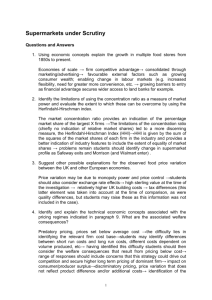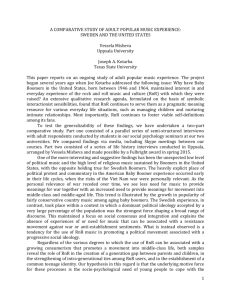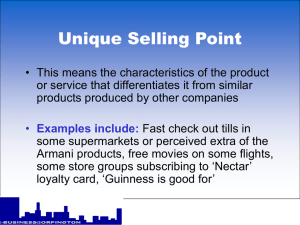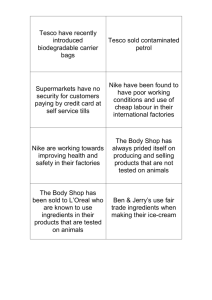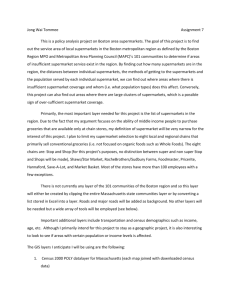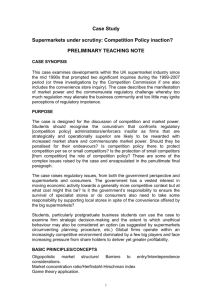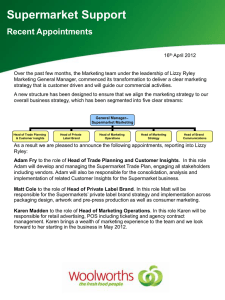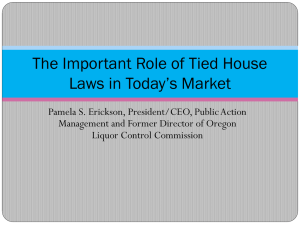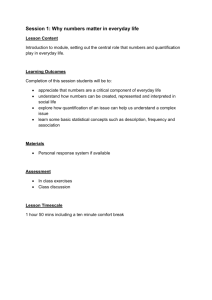Extended Essay in Economics
advertisement
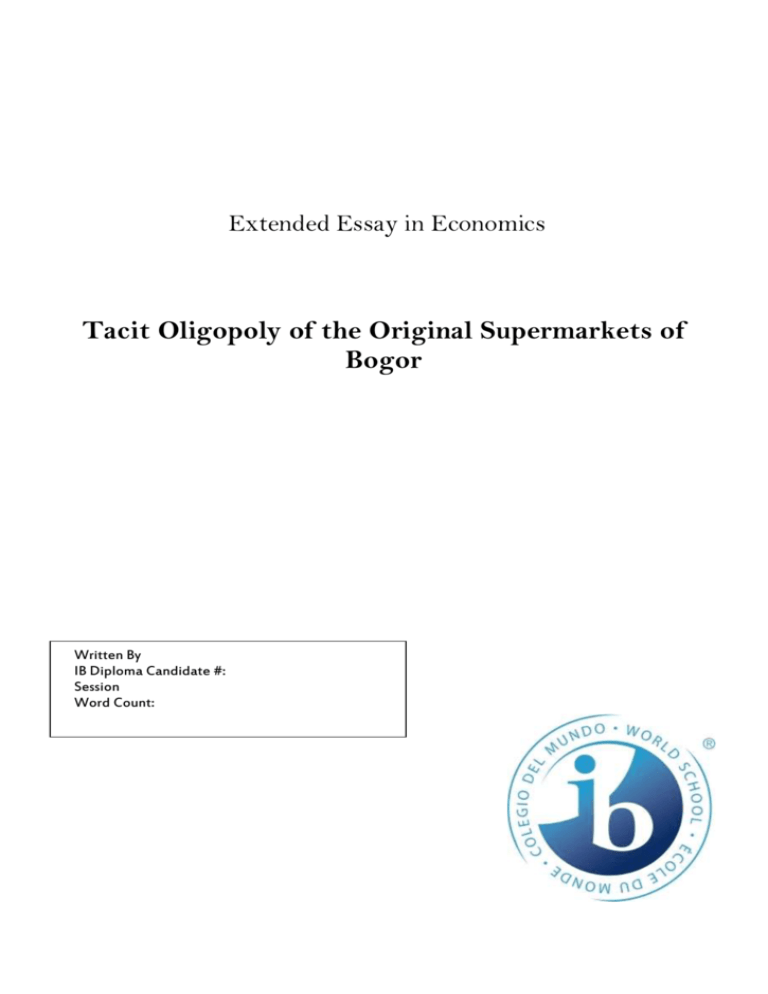
Extended Essay in Economics Tacit Oligopoly of the Original Supermarkets of Bogor Written By IB Diploma Candidate #: Session Word Count: Abstract The grocery market of Bogor has been facing a significant change during the past several years. Sudden emergence of new suppliers has more than doubled the number of existing supermarkets. I took interest at the fact that despite of the sudden increase in the number of suppliers, there never was a price decrease. This signifies that the market is experiencing Over Supply. I decided to investigate whether the strain caused by the over supply have changed a particular part of the market structure of the supermarkets of Bogor. I took a keen interest at whether the original supermarkets of Bogor form a tacit oligopoly to compete against new competitors. My first step was to investigate whether the supermarkets shows characteristics of an oligopoly. Several factors are apparent; the number of firms in the market is small, their size is relatively big, their products are slightly differentiated, and the entry barriers are high. To further strengthen my claim concerning the barrier, I have studied a small portion of two legal documents that concerns starting a supermarket business. Afterwards, I have recorded product prices and performed statistical analysis to determine whether the price range is narrow. I then compare the prices of the new supermarkets and all the supermarkets of Bogor as a whole. The result shows that indeed there is an oligopoly; yet it extends to reach the new supermarkets. This means that the original supermarkets have not segregated themselves to attempt gain business power (e.g. in pricing). New questions are formed based on the results. Among them is whether the oligopoly intentional or has competition with other suppliers, e.g. the traditional markets, caused the price range to be limited? These questions require further researches that are likely to orientate to the Business Studies disciplines. Word Count: 295 Table of Contents 1 Abstract 1 Table of Contents 2 Part 1: An Introduction to the Essay 3 Part 2: The Present Market Profile 5 Part 3: Review of Relevant Theories 7 Part 4: Hypothesis and Methodology of Research 10 Part 5: Data Collection and Analysis 12 Part 6: Conclusion and Evaluation 17 Bibliography 18 Appendix 1____ 19 Appendix 2 20 Appendix 3 21 Acknowledgements 22 Part 1: 2 An Introduction to the Essay Bogor is a minor city that is founded over two centuries ago, thus by now it is well known by its surrounding cities and villages. The city was established as a center of trade for local agricultural industries (Encarta). As a citizen of the city ever since birth, I know well that the grocery market of the city is massive. The vast and well known open air market of fresh produces called Pasar Bogor (or ‘the Market of Bogor’), numerous minor grocers, five notable supermarkets, and the easily accessible shopping centers in Jakarta have supplied the household demands of the 3,696,848 citizens residing in Bogor (the figure was recorded at a 1997 census) (Encarta). The market status, however, have taken a significant turn during the last 10 years. Numerous new suppliers entered the market; among them are as much as five new supermarkets (doubling the present number), two hypermarkets, and two new mini-market chains. Among the very basic principles taught to economics students is the Market Equilibrium law. It states that the demand and supply of a product is dependent of the price level. The consumers prefer lower prices while the suppliers prefer higher prices. Where the two quantities met, it is called the Equilibrium point. (Collier, 201) Diagram 1.0 shows this point of importance as (q1, p1). Diagram 1.0. The Micro Economic Model of the Grocery Market A sudden increase in supply that was not due to a price change signifies that there is a shift in the Supply line. Diagram 1.0 portrays this scenario by having the line labeled ‘Supply 1’ shift to 3 become ‘Supply 2’. This shift will cause the equilibrium to increase in quantity but decrease in price (Collier, 191). However, there never was a significant price decrease in the grocery market of Bogor. The supply line may shift, but the price is maintained at p1, and theoretically this must result in an Over Supply. An Over Supply occurs when the quantity of supply exceeds the quantity of demand. (Collier, 203) Diagram 1.1. Illustration of the market experiencing Over Supply The Over Supply strains the suppliers, since it means that some of their stock will remain stagnant and inevitably experience depreciation –which in turn will result in business failure. Despite, logically thinking, the side that was experiencing the biggest lost of consumers will be the suppliers (supermarket, etc.) in Jakarta; inevitably the local suppliers of Bogor too will share part of the strain. However, the pressure will not be as hard on the new competitors as it would be to the original suppliers since all new competitors belong to a nationwide company (details are located in part 2: the Present Market Profile). There is the possibility that the demand line has shift along (or even preliminary) to the shift of the supply line. However, through observation I have noticed that there never was an apparent change in the factors that may trigger a shift of the demand line. Those factors are: price of substitute products, price of complementary goods, general income and taste (preference), the population, and advertisements (Glanville, 24). 4 The original supermarkets (from this point this term will be used to refer to the supermarkets that have existed before the sudden emergence of new competitors) concerned me the most. The Market of Bogor and other minor suppliers surely offered the least prize, thus they have a separate market segment. My concern would be whether the business pressure is strong enough for the original supermarkets to from a tacit oligopoly. Thus was formed the research question: Did the original supermarkets of Bogor form a tacit oligopoly to compete against the new competitors? The next part of the essay will reveal the present market profile. Following it will be a review of relevant theories, which serves as a base for the hypothesis. After discussing my methods of research to verify my hypothesis, the data collected will be presented and analyzed. Thus, a conclusion will be formed, along unanswered questions and possible sources of error. 5 Part 2: The Present Market Profile Here is a list of the present entities of the market: Original Supermarkets: Ngesti Supermarket (3 outlets) Grand Supermarket Shangri-La Supermarket New Supermarkets: Hero Supermarket Matahari Marketplace A&G Groceries ADA Supermarket Ramayana Supermarket New Hypermarkets: Giant Hypermarket Hypermart Hypermarket. New Mini-markets: Indomart Alfamart Other competitors: The Market of Bogor Minor Grocers Suppliers (supermarket, etc.) of Jakarta A ‘minor grocer’ is a reference towards traditional Indonesian grocery suppliers, known locally as ‘waroengs’. It tends to be a small store, not often would you found one the size of a typical bathroom. The goods it sells are usually minor needs, such as cigars, sweets, and hygiene products. The appearance of the outlets tends to be ignored and they could be found dispersed around the vicinity of the city. However, the term ‘mini-markets’ refers towards literal small supermarkets. Its design and facilities equal those of a supermarket and thus it presents its customers with every benefits of a 6 supermarket besides variety of product. The mini-markets belong to a nationwide chain and they have an outlet in seemingly every residential area of the city. Despite being under the same brand, the three outlets of Ngesti Supermarket belong to different people. It originated as a Private Limited company, but now the three branches are run separately by three children of the original founder. Every new entity belongs to a company-chain or to a public limited company: (Note: ‘Pt…Tbk’ is the Indonesian label for a Public Limited company) Hero Supermarkets and Giant Hypermarket belong to PT. Hero Supermarket Tbk. Matahari Market Place (a supermarket) and Hypermart (a hypermarket) belong to PT. Matahari Putra Prima Tbk. Ramayana Supermarket belongs to PT. Ramayana Lestari Sentosa Tbk. AG Mart Groceries and ADA Supermarket belong to different companies but both own more than one outlet situated in different cities of the country. The mini-market chain Indomart belongs to PT. Indomarco Prismatama (a Limited company that belongs to the Indofood group, whose owner once so far as become Indonesia’s richest entrepreneur). The Alfamart mini-market chain belongs to PT Sumber Alfaria Trijaya Bidang Usaha (a Limited company) and is about to be integrated to PT Ramayana Lestari Sentosa Tbk that owns the Ramayana Supermarket (see above). 7 Part 3: Review of Relevant Theories Ceteris Paribus Ceteris Paribus is an assumption that every factor other than the one being discussed remains constant (Glanville, 10). Every part of this essay is written on Ceteris Paribus. Various Forms of Market Structure To investigate whether the original supermarkets of Bogor have formed an oligopoly, first the characteristic of that particular market structure and other alternatives must be pre-determined. 1). A Monopoly This is a market where there is a single seller. It has absolute control over the prices of the market due the unavailability of substitute products. Due to this fact, often times monopolies are placed under strict control of the government. (Glanville, 120) A monopolized market requires the highest forms of barrier of entry. This means that people interested in entering the market ought to proceed through many difficult requirements which often was impossible to attain. The highest barrier that one may encounter is governmental laws, and indeed it was often intentionally employed to create monopolies. (Collier, 269) A good example would be Indonesia’s PLN, its sole electricity supplier for the whole nation. It was the only entity in the market for mass electricity and legal laws forbid any enterprise to enter the market. In this particular case, the government owned the company. This grants them maximum control over the market. The huge sales volume was directed towards the government’s fund. 8 2). Assumptions of an Oligopoly An oligopoly is a market situation where there are few sellers and each firm may be aware of the activities of another. There are high barriers of entry –but these are lower than those of a monopoly. The products they offered tend to be differentiated goods, this refers to goods that are derived from an original form (e.g. shampoos may be differentiated to anti-hair-loss, scalp oil controlling, etc). (Glanville, 140) The few firms in the market collude together and act like a monopoly formed by many entities. A formal collision is called a cartel, and the original supermarkets of Bogor do not belong to a formal cartel. An unofficial collusion is referred to as a tacit oligopoly. (Glanville, 140) The colluding firms will have an agreement about price range, advertising, market share, and possibly corporate business strategies. Their semi-monopoly allows the firm sizes to be big. (Glanville, 140) 3). Assumptions of a Monopolistic Market A monopolistic market is when many firms compete in the same market, selling similar yet differentiated goods or services. The barrier of entry is relatively low compared to the previous two market structures discussed. (Glanville, 114) Jeans and brand-less t-shirts are examples of products that are close substitutes of each other but are differentiated. A consumer may switch his preference from one brand to another and will not experience a significant change in utility. Note however, that when talking about such products, there are several items on the market with very distinguished feature (special brand of clothing, etc.) that belongs to niche markets. These products are not part of a monopolistic market. The degree of price control (however weak) of a monopolistic market is attributed towards this slight differentiation. If the product is entirely homogenous, no firm will have control over its prices, turning it into a Perfect Competition Market. (Glanville, 114) 9 4). Assumptions of a Perfect Competition Market A perfect competition market houses extreme amounts of producers, none of which possessing a high rate of market share. The products are homogenous (exactly the same), and the barrier of entry is near to non-existent. No firm has any influence over the market’s price. The homogeneity of the product does not allow selling above market price (since it will result in severe loss), and the fierce amount of competition did not allow the firms to engage in a price war strategy (setting price lower), since the market price is already set as close to the cost of production as it could be. If indeed the current price is a degree above the average cost of producing the goods, then a firm may employ a price war strategy and enjoyed supernormal profit for a period of time, but other competitors will follow suit immediately. Here is a table that summarizes the elements of the four market structures discussed previously: Market Structure Number of Firms Typical Size of Firms Product Homogeneity Entry Barriers Examples Monopoly One (sole supplier) Usually very large No substitute Blockade or almost impossible National companies Oligopoly Few Differentiated Significant Monopolistic Many Very large Differentiated but similar Almost identical or even identical Relatively easy Barely any Hygiene products Garments Perfect Competition Relatively Big Relatively small Small 10 Garden produces Part 4: Hypothesis and Methodology of Research My hypothesis is the original supermarkets of Bogor have formed a tacit oligopoly that is separate from the new supermarkets to gain business power. As discussed in the introduction and the market profile section of this essay, it is unquestionable that the original supermarkets experience a degree of pressure from the sudden establishment of new competitors. I believe that it is only logical for them to attempt making the overall competition more endurable by forming a segregated oligopoly. This way, they may attempt corporate business strategies, especially on the matter of pricing. To prove this hypothesis, I must attempt to correlate the supermarkets with characteristics of an oligopoly. Those are: Number of firms: few. Products are slightly differentiated (as in groceries). Size of firms: relatively big. High barrier of entrance. Similar price range. The first three characteristics are theoretical and apparent. There are a small number of firms (compared to the monopolistic food and beverage business or the perfect competition green grocers, for example). All supermarkets sell many identical products (common brand and package size) and the nature of these products is in general only slightly differentiated. The size of the firms too is relatively big, proven to us by the existence of mini-markets which are smaller representatives of supermarkets. As of the barrier of entering the market, it is only logical that it is high. A supermarket is visibly a large scale business –meaning that it requires a big amount of capital to start. Furthermore, the products offered by a supermarket are numerous in variety. For every single product they would have to prepare legal methodologies of payment, storage, delivery, and shelf placement –this surely is a significant entry 11 barrier on its own. So, I believe it is endorsable to conclude that the barrier of entry to the supermarket business is high. The last missing information is their product prices. I will record the prices of all supermarkets and perform statistical analysis to determine their price range. If the prices posed by the original supermarkets are similar to each other, then it is proven that they indeed do form a tacit oligopoly. The next part of the research would be comparing the price of the original supermarkets to the new supermarkets. Afterwards I shall perform identical mathematical analysis as before. If indeed the two results (the first being the price range of the original supermarkets alone and the second data being the price range of all supermarkets) are different, then indeed we would know that the original supermarkets of Bogor have formed an oligopoly that segregated them. Diagram 4.0 shows the Market with the original supermarkets segregating themselves and formed an entirely new team (oligopoly). This way, possibilities to compete better will open to them, e.g. a corporate pricing strategy. However, if their price range is similar, then we may conclude that all the supermarkets as a whole is an oligopoly and so the original supermarkets have not segregated themselves by making an oligopoly of their own. 12 Diagram 4.1 shows an oligopoly that includes both the original and the new supermarkets. 13 Part 5: Data Collection and Analysis Before proceeding with the price analysis, I would like to strengthen my claim concerning the high entry barrier. Here are parts of two legal documents that concern opening a new supermarket business. Note that the documents are written in the Indonesian language (Bahasa Indonesia), thus the translations present are my personal attempt. Here is a transcript from the ‘Perda tentang Pengelolaan Usaha Industri Kabupaten Bogor [Regional Regulation Concerning the Managing of Industries in the Bogor Region]’: Surat Izin Usaha Perdagangan [Legal Permission of Retail Businesses], hereby referred to as SIUP, is a permission to commence retail business activities. (Transcript from Web Terintegrasi Kabupaten Bogor) Thus we know the SIUP is necessary to start the business. The conditions of attaining a SIUP present a more apparent barrier. SIUPs are differentiated according to business size. It is only logical that supermarkets are considered a large retail business, therefore: Business activities may posses a SIUP for large retail if the investment value is above Rp. 500 million excluding land and building costs. (Transcript from PT. RCS Online Page) 14 To clarify the weight of this figure (Rp.500 million) to international readers of this essay, note that the GDP/Capitappp of Indonesia was merelyUS$3,900 (at 2006, according to the CIA World Fact Book). If converted to US dollars, Rp.500 million will become US$52,800.50 (based on today’s rate –today: 18th of August 2007). This means that an average person will need to accumulate all of his earnings for much more than a decade to enter the industry, having in mind that the number is merely the absolute minimum capital and it excludes land and building fees. Thus, we may formulate that indeed there is a very high barrier towards entering this industry. The next step would be to record the prices of the sample products in all the supermarkets. To provide a subjective data, the quality and quantity of the sample products should be a controlled variable; thus I have decided that the sample products to be investigated should be branded goods of the same package size. To further make the investigation more reliable, I will record all prices during the same day as to prevent price fluctuations. The two statistical analysis methods necessary to analyze this data are the mean (average) and the standard deviation (how much is the standard rate of the prices’ deviation from the mean). The standard calculated by: To calculate the mean of a series of data, the formula would be: x deviation 1 n ( xi x) 2 n i1 n 1 xi n i 1 where: where: σ = Greek symbol ‘sigma’ (in lower = the mean of the series of data n = the number of terms. case) which represents standard xi = the value of the term i. deviation. n = the number of terms xi = the value of the term i. (Urban, 463) = the mean of the series of data (Urban, 485) 15 is Here is the result of the calculations. For the detailed list of prices, please refer to Appendix 1. Product Mean of Original Supermarkets Mean of New Supermarkets Mean (Overall) SD of Original Supermarkets SD of New Supermarkets SD (Overall) Frisian Flag Milk Full Cream 1000gr Rp46,600.00 Rp44,940.00 Rp45,770.00 4.42% 1.58% 3.70% Ovale Skin Tonic 200ml Rp9,940.00 Rp10,370.00 Rp10,155.00 8.41% 13.32% 10.83% Sariwangi Bagged Tea 150mg Rp6,400.00 Rp5,868.00 Rp6,134.00 9.38% 5.98% 8.83% Blue Band Margarine 250 mg Rp4,375.00 Rp4,425.00 Rp4,400.00 4.28% 5.88% 4.90% Pepsi Cola 500mg Rp4,460.00 Rp4,520.00 Rp4,490.00 11.19% 4.98% 8.16% SoKlin Lantai Floor Cleaner 800 mg Rp4,850.00 Rp5,161.00 Rp5,005.50 3.18% 6.61% 5.96% Rp4,310.00 Rp4,453.00 Rp4,381.50 3.00% 10.81% 7.77% Rp10,680.00 Rp10,485.00 Rp10,582.50 2.60% 10.17% 7.01% Oreo Biscuits150g Lifebuoy Body Wash 300ml The original supermarkets showed a similar price range. The biggest deviation is merely 11.19%, meaning the average difference in price was only 11.19% of the mean price. However, the new supermarkets’ average prices did not differ greatly with the prices of the original supermarkets. There is no repetitive trend on which one side always poses a higher/lower price than the other. This means that the oligopoly that the original supermarkets have made extends to all of the supermarket industry. If the original supermarkets have created a separate oligopoly to compete with the new competitors, evidence of them segregating themselves would be visible. Their prices will have a trend that is close to each other yet different from the new 16 supermarkets. However, in the chart above, we could see that for some products, the prices were generally cheaper in the original supermarkets yet for some others it was cheaper in the new supermarkets. Furthermore, the overall standard deviation shows that both sides’ prices did not differ significantly. The question now will be, ‘why have not the original supermarkets made a new oligopoly?’ One factor to question would be whether the profit margin for grocery products will allow further price deduction. Further investigations of this possibility however must derive from the disciplines of economics and orientate to areas of business studies and this essay will not further develop this idea for that reason. Another notable factor is that by not posing a corporate pricing strategy, the original supermarkets are ready to engage in a non-price competition with the new suppliers. What made them prefer doing so? To complete the analysis, that question must be answered. After investigating economics textbooks, I discovered that there exists a form of oligopoly named Non-collusive Oligopoly. A market is labeled so when the firms met all characteristics of an oligopoly but they compete among themselves in ways that did not involve price. In its place, the firms may compete in branding, advertising, free offers, and promoting quality and price. (Glanville, 140) The original supermarkets of Bogor have a beneficial factor that readied them for a non-price competition; it is the fact that they are original. During the years before the new supermarkets entered the market, surely the original supermarkets have built a strong customer base. It is known that all original supermarkets except for Shangri-La Supermarket are Sole Proprietorships –meaning they are owned by one person. The owners managed the shop as a whole and not separate it into departments. Often would they be seen directly involved in the shop floor. This signifies that direct customer approach is something that occurs very often, this is a favorable factor in building a customer base. However, the threat for them would be that their customer loyalty surely is limited towards the older population. Young ones who, before the emergence of the new supermarkets, have not integrate shopping as part of their routine surely did not have such loyalty. When the demography shifts, the main advantage of the original supermarkets may be eliminated. 17 Nevertheless, if we decide to disregard the non-price competitive power of the original supermarkets, a new argument might arouse. Have the supermarkets of Bogor turn into a monopolistic market? Where no firm has a high degree of price control and so everyone is selling at their absolute minimum profit. The answer to this will certainly be negative. It is true that the number of the entities has increased, but I believe that it is not big enough to deform the market structure to become a monopolistic market. An empirical evidence is that the prices posed by the original supermarkets and the new supermarkets differ –and the difference is not of a common percentage. Look at Appendix 3 for details. This fact does not only signifies that the firms were not selling at the absolute minimum price, but it also shows that the supermarkets each have a degree of control over their price. The comfort and practicality of supermarket shopping gave this power to the supermarkets; they have the power to set higher prices. This means that they are not a monopolistic market yet. Another possibility as of why there is no corporate pricing strategy is, if referred to the concept of ‘the Prisoner’s Dilemma (PD)’ it will be visible that it is favorable that all supermarkets set their prices high. The PD, if applied to the present case, will resemble the market as: New Supermarkets (NS) Low Price Original Supermarkets (OS) High Price 18 Low Price High Price Medium revenue for both Low revenue for NS, very high revenue for OS High revenue for both low revenue for OS, very high revenue for NS If one side of suppliers poses high prices and the other side poses lower prices, customers will prefer the less expensive side –this will result in great revenues for them and low revenues for the entities with higher prices. Thus the best scheme for all suppliers is for everyone to set high prices –and the grocery market of Bogor has the power to do so; since as discussed before, as a whole they are an oligopoly. 19 Part 6: Conclusion and Evaluation This main aim of this essay is answer the question “Did the original supermarkets of Bogor form a tacit oligopoly to compete against the new competitors?” It is proven through the collected data that there is an oligopoly between the original supermarkets, but this oligopoly extends to include the new supermarkets as well. I hypothesized that the original supermarkets have formed a separate oligopoly in which they may employ corporate pricing and other business strategies. It is now proven wrong. This also implies that the original supermarkets are willing to engage a non-price competition. However, this investigation process is limited. To maintain subjectivity, I have decided that branded goods would be the only appropriate sample products; these products allow quantity and quality to be controlled. If non-branded goods are taken into account, the fluctuation of price might be greater. Those goods’ values are subjective and the supermarket’s brand image will definitely alter its value in the eyes of the consumer. This gives the supermarkets a higher degree of price control. Furthermore, the price recording is held only once. There might be a trend of price change that depends on the time of the year or the day of the week and which I might have failed to apprehend. Apart form the price recording process, there are other limitations as well. Despite there is a figure for GDP/Capita, income disparity is not integrated into it. Lastly, there are several new questions that emerge from these results. Is the oligopoly intentional or was it a necessity to compete with other suppliers, e.g. the hypermarkets? Or was there a corporate pricing strategy (a separate oligopoly) once but the new supermarkets has adapted their prices unto it? Despite these questions derives from the purpose of this essay, they could be taken into consideration during future researches. 20 Bibliography 1). "Bogor." Microsoft® Student 2006 [CD]. Redmond, WA: Microsoft Corporation, 2005. 2). Collier, Barry. Introducing Economics. 2nd ed. Queensland: Jacaranda Press,1992. 3). Glanville, Alan. Economics from a Global Perspective. Oxford: Glanville Books, 2003. 4). “Indonesia.” The CIA World Fact Book. 16 Aug 2007 Central Intelligence Agency. 18 Aug 2007. <https://www.cia.gov/library/publications/the-worldfactbook/geos/id.html> 5). “KETENTUAN STANDAR PEMBERIAN SURAT IJIN USAHA PERDAGANGAN (SIUP)” 2002. PT.RCS Online Page. PT. Roda Cipta Semesta. 18 Aug 2007. < www.rcs.co.id/kepmendprin_289_2001.htm>. 6). “Perda tentang PENGELOLAAN USAHA INDUSTRI DAN PERDA.” 2002.Web Terintegrasi Kabupaten Bogor. Bupati Bogor. 18 Aug 2007. <http://gerbang. jabar.go.id/kabbogor/index.php?index=15&idartikel=1>. 7). Urban, Paul, et al. Mathematics for the International Student: Mathematics HL (Core). Adelaide: Haese & Harris Publications, 2004. 21 Appendix 1 Product Prices Posed by the Original Supermarkets Product Analysis Ngesti 1st Branch Ngesti 2nd Branch Ngesti 3rd Branch Grand Supermarket Shangri-la Supermarket Mean Standard Deviation Frisian Flag Milk Full Cream 1000gr Rp44,700.00 Rp44,300.00 Rp47,400.00 Rp47,400.00 Rp49,200.00 Rp46,600.00 4.42% Ovale Skin Tonic 200ml Rp10,800.00 Rp9,600.00 Rp8,900.00 Rp9,600.00 Rp10,800.00 Rp9,940.00 8.41% Sariwangi Bagged Tea 150mg Rp6,900.00 Rp6,700.00 Rp5,800.00 Rp5,700.00 Rp6,900.00 Rp6,400.00 9.38% Blue Band Margarine 250mg Rp4,625.00 Rp4,200.00 Rp4,200.00 Rp4,500.00 Rp4,350.00 Rp4,375.00 4.28% Pepsi Cola 500mg Rp5,250.00 Rp4,350.00 Rp460.00 Rp4,000.00 Rp4,100.00 Rp4,460.00 11.19% SoKlin Lantai Floor Cleaner 800 mg Rp4,850.00 Rp4,700.00 Rp4,750.00 Rp4,850.00 Rp5,100.00 Rp4,850.00 3.18% Oreo Biscuit 150g Rp4,350.00 Rp4,300.00 Rp4,150.00 Rp4,250.00 Rp4,500.00 Rp4,310.00 3.00% Lifebuoy Body Wash 300ml Rp10,900.00 Rp10,700.00 Rp10,200.00 Rp10,800.00 Rp10,800.00 Rp10,680.00 2.60% 22 Appendix 2 Product Prices Posed by the New Supermarkets AG Mart Hero Supermarket ADA Supermarket Matahari Market Place Ramayana Supermarket Frisian Flag Milk Full Cream 1000gr Rp45,600.00 Rp45,600.00 Rp43,900.00 Rp44,700.00 Rp44,900.00 Ovale Skin Tonic 200ml Rp8,500.00 Sariwangi Bagged Tea 150mg Rp5,500.00 Blue Band Margarine 250mg Rp4,100.00 Product Pepsi Cola 500mg SoKlin Lantai Floor Cleaner 800 mg Rp11,150.00 Rp6,275.00 Rp4,675.00 Rp9,450.00 Rp6,000.00 Rp4,675.00 Rp11,950.00 Rp6,065.00 Rp4,225.00 Mean Standard Deviation Rp44,940.00 1.58% Rp10,370.00 13.32% Rp5,868.00 5.98% Rp4,425.00 5.88% Rp4,520.00 4.98% Rp5,161.00 6.61% Rp4,453.00 10.81% Rp10,485.00 10.17% Rp10,800.00 Rp5,500.00 Rp4,450.00 Rp4,500.00 Rp4,150.00 Rp4,600.00 Rp4,750.00 Rp4,600.00 Rp5,400.00 Rp5,415.00 Rp4,775.00 Rp5,415.00 Rp4,800.00 Oreo Biscuit 150g Rp3,850.00 Rp4,290.00 Rp4,300.00 Rp5,125.00 Rp4,700.00 Lifebuoy Body Wash 300ml Rp9,700.00 Rp11,925.00 Rp10,300.00 Rp11,175.00 Rp9,325.00 23 Analysis Appendix 3 Product Prices (Comparison) Product Prices Posed by the Original Supermarkets Product Prices Posed by the New Supermarkets AG Mart Hero Supermarket ADA Supermarket Matahari Market Place Ramayana Supermarket Rp49,200.00 Rp45,600.00 Rp45,600.00 Rp43,900.00 Rp44,700.00 Rp44,900.00 Rp9,600.00 Rp10,800.00 Rp8,500.00 Rp11,150.00 Rp9,450.00 Rp11,950.00 Rp10,800.00 Rp5,800.00 Rp5,700.00 Rp6,900.00 Rp5,500.00 Rp6,275.00 Rp6,000.00 Rp6,065.00 Rp5,500.00 Rp4,200.00 Rp4,200.00 Rp4,500.00 Rp4,350.00 Rp4,100.00 Rp4,675.00 Rp4,675.00 Rp4,225.00 Rp4,450.00 Rp5,250.00 Rp4,350.00 Rp460.00 Rp4,000.00 Rp4,100.00 Rp4,500.00 Rp4,150.00 Rp4,600.00 Rp4,750.00 Rp4,600.00 Rp4,850.00 Rp4,700.00 Rp4,750.00 Rp4,850.00 Rp5,100.00 Rp5,400.00 Rp5,415.00 Rp4,775.00 Rp5,415.00 Rp4,800.00 Oreo Biscuit 150g Rp4,350.00 Rp4,300.00 Rp4,150.00 Rp4,250.00 Rp4,500.00 Rp3,850.00 Rp4,290.00 Rp4,300.00 Rp5,125.00 Rp4,700.00 Lifebuoy Body Wash 300ml Rp10,900.00 Rp10,700.00 Rp10,200.00 Rp10,800.00 Rp10,800.00 Rp9,700.00 Rp11,925.00 Rp10,300.00 Rp11,175.00 Rp9,325.00 Product Ngesti 1st Branch Ngesti 2nd Branch Ngesti 3rd Branch Grand Supermarket Shangri-la Supermarket Frisian Flag Milk Full Cream 1000gr Rp44,700.00 Rp44,300.00 Rp47,400.00 Rp47,400.00 Ovale Skin Tonic 200ml Rp10,800.00 Rp9,600.00 Rp8,900.00 Sariwangi Bagged Tea 150mg Rp6,900.00 Rp6,700.00 Blue Band Margarine 250mg Rp4,625.00 Pepsi Cola 500mg SoKlin Lantai Floor Cleaner 800 mg 24 Acknowledgements I would like to credit: Santo Gultom, as my Extended Essay supervisor, Economics teacher, and IB Coordinator (2007-2008). Kale Hanson, as my IB Coordinator (2006-2007). I also acknowledge the supermarkets that were subject to my research: Ngesti Supermarket Ngesti Supermarket 2nd Branch Ngesti Supermarket 3rd Branch Grand Supermarket Shangri-La Supermarket Hero Supermarket Matahari Marketplace A&G Groceries ADA Supermarket Ramayana Supermarket 25
